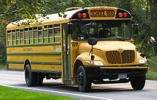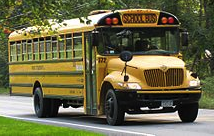An accident is defined as a collision between the school bus/van and a moving or stationary object. An accident can result in vehicle damage and/or passenger injury. The driver shall report EVERY ACCIDENT IMMEDIATELY whether students are on board at the time or not to the transportation office.
These procedures should be carried out as quickly as possible.
- Stop the vehicle at the scene of the accident, no matter how minor. Set the parking brake, activate the hazard warning flashers to alert other motorists, turn off all other lights and electrical switches, and turn off the ignition switch and remove the key.
- After the incident do not move your bus. Documentation of the final positions of the vehicles involved in the incident is extremely important to the accident investigation. Move the vehicle only when directed by the police. Do not move the bus simply to let traffic pass.
- Remain calm and in control. Your attitude and actions will have an enormous impact on how the students react during the aftermath of the incident, especially with special needs students. Reassure the students.
- Assess the situation after the incident. If a fire is present or the potential for a fire exists, evacuate the students. Also, look for any possible hazardous materials that may present a danger to you or the students. Evacuate students if a danger exists from chemicals, vapors, or other toxic substances.
- Check students for injuries, if necessary, administer first aid to injured students. Do not exceed your limits providing first aid. Do not move any injured student unless absolutely necessary.
- Contact the transportation office via radio or phone (973 664-2354). Give the office the following information: your exact location, report on injuries, any danger of fire, is the bus being evacuated. If base does not respond, please repeat your basic message again, giving your bus number each time. Base may hear you but you are unable to hear base. If evacuating the bus, ensure the radio is on by pressing the power button on it and place the microphone out the driver’s side window for possible use outside the bus. All other drivers should clear the airwaves whenever there is an emergency unless a “Relay” of communications is necessary. The transportation office will contact the local police department during normal working hours. When the transportation office is closed, the driver will contact the Transportation Dispatcher or if it is an emergency, dial 911 then contact the Dispatcher.
- If a driver is experiencing a mechanical breakdown on a major highway, the driver is to assess as to how perilous the situation is (possibility of fire, being struck by any other moving vehicles, etc.). Once this is determined driver should gather the following information before contacting 911 requesting police assistance:
- Who you are (Driver Name, the entity you work for, vehicle number);
- Exact location;
- Number of passengers on board (students, coaches and/or chaperones);
- Depiction of the incident (flat tire, overheating, etc.);
- Protect the scene until police arrival;
- If an evacuation is needed, let the 911 dispatcher know and if possible, wait for the police arrival. If not, identify a safe location away from any possible danger, to evacuate all passengers;
- Then contact MHRD dispatcher on duty and relay all pertinent information and steps taken, then await for instructions.
- Protect the accident scene by placing reflective triangle warning devices in their appropriate locations warning oncoming traffic of a disabled vehicle. Make sure to activate your 4-way flashers. If you have evacuated students be sure they are in a safe area and remain together.
- Account for all passengers. Provide first responders with the exact number of students on board and if any have special needs.
- Request anyone who had observed the accident to remain until the police arrive. Jot down license plate numbers of vehicles at the scene, especially of potential witnesses who are leaving before the police arrive. If no witnesses are available, identify the first people who arrived at the scene.
- Do not release students from the accident scene investigation unless instructed by law enforcement, school officials, or unless emergency medical treatment is required. Cooperate with the authorities. As the police and emergency personnel arrive they will take over.
- When talking with other motorists, be professional and polite, but admit nothing, and don’t argue. What you say at the accident scene may be admissible in court. Do not discuss the accident with anyone other than law enforcement or school administration.
- If approached by the media, politely inform them that the district policy does not allow drivers to comment at the scene. Instruct the media to talk with the School Business Administrator (973-664-2281).
- In each bus/van there is a Motor Vehicle Accident Report Kit. The kit, vehicle registration, and insurance card are to be kept in the document holder located in the driver’s compartment. Upon returning to the transportation office after the accident the completed “Preliminary School Bus Accident Report” is to be turned in to the Transportation Coordinator. The Coordinator will then submit the report to the State Department of Education as required. Any documents received from the investigating police officer are to be turned in to the Coordinator (Accident Report #, Case #, etc.).
Last modified:
7 May 2020


